Buenos Aires Underground rolling stock
The Buenos Aires Underground has one of the most diverse metro fleets in the world, and has had some of the oldest models in operation on any network. The network began with a relatively standardised fleet, but throughout its over 100-year-long history, it has seen numerous purchases which have created cases where some lines operate numerous models. Recently there have been increased efforts to modernise and standardise the fleets, with large purchases from China CNR Corporation and Alstom.
History

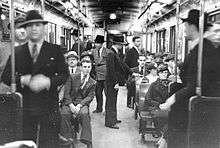

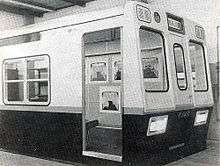
Before the nationalisation of the railways and the formation of Subterráneos de Buenos Aires, the original lines of Buenos Aires Underground were built by three private companies, and each bought different rolling stock for their lines.
Line A was inaugurated in 1913 by the Anglo-Argentine Tramways Company (AATC)—then owned by the Belgian company Sofina—who owned the vast majority of the city's tramways at that point. Two companies competed to provide the rolling stock of the line: the Belgian La Brugeoise et Nivelles and British United Electric Car Company, with the Belgian company ultimately winning the contract.[1] However 4 UEC Preston cars had been sent to the country and these more extravagant cars were kept in service on the line until the 1970s and were often used on special occasions.[2] The Brugeoise cars made up the entirety of the rolling stock of the line until 2013, retiring just before their 100-year anniversary.[3]
The Argentine company Lacroze Hermanos built Line B, originally designed to be an underground continuation of the Buenos Aires Central Tramway (today the Urquiza Line). The line has historically been significantly different from the others in terms of rolling stock since it uses third rail electrification instead of overhead lines and as such, it has been the most troublesome to standardise and has often had the most diverse rolling stock, with four different models circulating on its tracks at one point. Originally served by Metropolitan-Cammell cars from its opening in 1930, these were later reinforced by cars from the Osgood Bradley Car Company in the 1950s. Later on, two attempts were made by the state-owned Fabricaciones Militares to replace the rolling stock of the line, however these were never produced in enough numbers to replace all the cars on the line. It was only in 1996 that the line was standardised again when cars were bought second-hand from the Tokyo Metro Marunouchi Line in order to replace all the cars. This was also the first time in the history of the network that cars were bought second-hand.
Lines C, D and E were all built by the Hispanic-Argentine Company for Public Works and Finances (CHADOPyF) in the 1930s and 1940s and were thus the most straightforward. All the lines used German Siemens-Schuckert Orenstein & Koppel rolling stock from their inaugurations, though during the 1960s Spanish-built CAF-General Electrica Española were added to the lines. The CAF-GEE cars were designed to be highly compatible with the Siemens-Schuckert Orenstein & Koppel cars in order to reduce maintenance costs.[4][5][6][7] It was only in the 1980s that the rolling stock started to diversify on these lines when Fiat-Materfer cars began to be introduced in order to standardise all the lines of the network (with the exception of Line B) using this rolling stock, however not enough of these were built to replace the Brugeoise, CAF and Siemens cars, so the ended up being spread thinly and switched between lines as temporary stock since their introduction.[5]
The standardisation across lines was further reduced following privatisation in the 1990s when more attempts were made to replace the ageing Brugeoise and Siemens stocks with second hand purchases from Japan and the incorporation of the new Alstom Metropolis 100 Series rolling stock, none of which were purchased in enough numbers to make up the entirety of a line, let alone multiple lines on the network.[5] Only in 2010s have there been moves towards re-standardising and modernising the fleet whilst retiring the ageing trains which had served since the opening of each respective line. Numerous purchases of new rolling stock have been made, along with the purchase of second hand rolling stock which the City Government claims is a necessity given the need to quickly incorporate trains in lines with rolling stock deficits.
Historical Fleet
| Model | Photo | Years active | Country | Purchased New | Cars built/purchased | Former Lines |
|---|---|---|---|---|---|---|
| La Brugeoise | 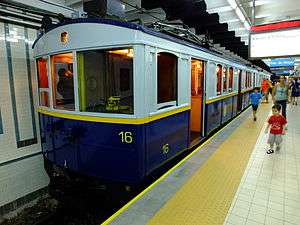 | 1913–2013 | Yes | 125 | ||
| UEC Preston[8] | 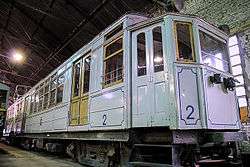 | 1913–1977 | Yes | 4 | ||
| Metropolitan Cammell |  | 1930–1996 | Yes | 56 | ||
| Osgood-Bradley |  | 1931–1996 | Yes | 20 | ||
| Siemens-Schuckert Orenstein & Koppel[9][10] | .jpg) | 1934–2016 | Yes | ? | ||
| Fabricaciones Militares[12] | 1965–1996 | Yes | 14 | |||
| Siemens-Fabricaciones Militares[13] | 1977–1996 | Yes | 18 | |||
| Siemens-Emepa-Alstom[9][14][15][16] | 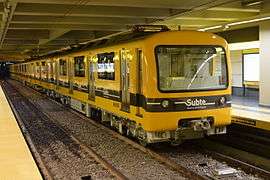 | 2014–2017 | Refurbished | 50 | ||
| CAF 5000[17][18] | .jpg) | 2013–2018 | No | 36 |
Preservation
The original La Brugeoise rolling stock has since been maintained, some in exhibition and some being converted to 1500 v to run tourist services on the line.[19] In December 2013 a law was passed which meant that the entire La Brugeoise fleet would receive protection status and would thus only be donated to organisations dedicated to their restoration and preservation.[20] The 3 surviving UEC Preston cars serve on the Buenos Aires Heritage Tramway above-ground in the neighbourhood of Caballito. Two Siemens-Schuckert Orenstein & Koppel also have been donated to the Buenos Aires Heritage Tramway, but the fate of the rest of the fleet is still unclear.[21]
On 1 February 2018, the Buenos Aires Heritage Tramway received a donation from SBASE consisting of a Metropolitan Cammell and a Siemens-Fabricaciones Militares.[22]
Current fleet
Rolling stock of the Buenos Aires Underground as of June 2018 (may not be current for all models).
| Model | Photo | Years active | Country | Purchased New | Cars built/purchased | Cars in operation | Former Lines | Current Lines |
|---|---|---|---|---|---|---|---|---|
| CAF/General Eléctrica Española[12] | _-_cropped.jpg) | 1968–present | Yes | ? | 56 | |||
| Fiat-Materfer | 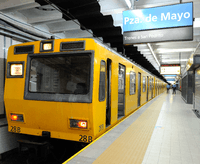 | 1980–present | Yes | 105[23] | 95 [24] | |||
| Materfer[26][27] | 1988–present | Yes | 17 | 13 | ||||
| Eidan 500 series [28] | 1996–present | No | 128[29] | 96[29] | ||||
| Nagoya 300/700/1200[30] |  | 1999–present | No | ? | 78 | |||
| 100 Series[31] | 2004–present | Yes | 96 | 96 | ||||
| 200 Series[32][33] | .png) | 2013–present | Yes | 150 | 150 | |||
| CAF 6000[34][33][35] |  | 2015–present | No | 72 | 72 | |||
| Nagoya 5000[36][37] |  | 2015-present | No | 30 | 30 | |||
| 300 Series[38][39][40][41][42][43][44] |  | 2016 | Yes | 180 | 162 (being phased-in) |
Green = current, Blue = future, Yellow = being phased-out.
Lines
Currently, the Underground is in a transitional period where temporary rolling stock is serving on numerous lines while orders arrive from China and Brazil. After these cars arrive from 2015 to 2016, the network will have far less diverse rolling stock, with Line A being composed entirely of CITIC-CNR trains, while lines D and H will be made up entirely of Alstom Metropolis trains. The older Siemens-Schuckert Orenstein & Koppel cars will be completely retired from the network, thus reducing the average age of the rolling stock significantly. With this move towards standardisation, some of the newer trains have received series numbers: the original Alstom Metropolis trains on Line D have been dubbed the 100 Series, the CITIC-CNR trains are the 200 Series, while the new Alstom Metropolis trains for lines H and D are the 300 Series.[45]
Line B will be composed of CAF cars purchased from the Madrid Metro while retiring the Eidan 500 cars, Line C will use a variety of Nagoya cars, while Line E will use Fiat-Materfer cars and refurbished Siemens-Schuckert Orenstein & Koppel cars, retiring the CAF/GEE cars. No plans have been made public about the long-term intentions with these lines, though Line C is receiving a modern communications-based train control system in preparation for newer rolling stock.[46] It has not been stated what rolling stock will be used on Line F, though the usage of platform screen doors on the line will require modern rolling stock and automated trains are being considered.[47]
Line A
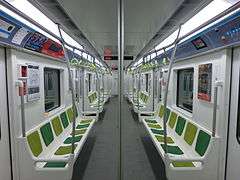
Until 2013, Line A had been served by La Brugeoise cars and a small number UEC Preston cars, which were retired prior to the Brugeoise cars. These were withdrawn from service on 12 January 2013, 11 months before their 100th anniversary and replaced by 45 new 200 Series cars built by China CNR Corporation.[48] However, the Chinese cars were not sufficient to cover the entire fleet of the line, so it had to be supplemented by a temporary fleet of 35 Fiat-Materfer cars, which was still not enough to replace the 120 La Brugeoise units and thus Siemens-Schuckert Orenstein & Koppel stock reformed by the Emepa Group was also added to the line to make up the numbers.[49] Furthermore, the replacement of the rolling stock coincided with the opening of the San José de Flores and San Pedrito stations and the line was still left with a rolling stock defect, causing a decline in passenger numbers.[50]
A further 105 CNR cars were ordered in 2014 so that the line would be served in its entirety by 150 of these 200 Series cars, and so the temporary replacement rolling stock could be moved to Line E in time for its extension to Retiro.[32] The cars have been steadily arriving into the country since 2015 and are being incorporated into the line, with the last of the CNR units are expected to arrive between 2016 and 2017, by which time Line A's rolling stock will consist entirely of these models.[32][51]
Line B
.jpg)

Line B has been historically the most diverse of the network given its significantly different characteristics to other lines and thus its rolling stock has not been uniform for most of its history. This was addressed in 1996 when rolling was purchased from the Tokyo Metro Marunouchi Line in order to make the line uniform. This was also the first time in the network's history that rolling stock was purchased second hand. In 2003, two stations were added to the line, followed by another two in 2013, meaning that the already old rolling stock was now also stretched to capacity. In 2011, it was announced that the Madrid Metro had sold some of its 5000 series trains to the Underground, which had been in operation in Madrid since 1974, and entered service in 2013 in order to make up shortfalls caused by the line's extensions. The 36 Spanish cars were of lower quality and reliability than the Japanese trains, despite being newer, and suffered a series of mechanical issues following their integration into the line.[17]
In July 2013, Madrid Metro sold 73 of its 6000 series cars (which entered service in Madrid in 1998) to Buenos Aires for $38.8 million in order to retire the rest of the Japanese-built trains.[52][53][54][55] A further 13 of these cars were purchased for $7.8 million, bringing the total up to 86.[34] The purchase of the CAF 6000 rolling stock has been met with criticism due to major alterations that were made to the line to accommodate the cars' height, as well as the fact that the second-hand units were not significantly cheaper than simply purchasing new rolling stock, and are not of particularly good quality, unlike the new Line A cars.[56][57] The biggest drawback of these cars is that, unlike the Eidan 500 and CAF 5000 cars, they use overhead electrification instead of third rail, and were thus unsuitable for the line, which had to be adapted to use both third rail and overhead electrification for what was by this point three models of rolling stock circulating on the line.[34] Similarly, changing to overhead lines would mean that the potential for an overground branch of the line from Federico Lacroze using Urquiza Line tracks would be lost since that line also uses third rail electrification. Following a series of setbacks caused by the power inefficiency of these trains, as of August 2015 it was unclear if they would be used on the line or moved elsewhere and new plans drawn up for the line which would not involve Spanish rolling stock.[58]
Line C
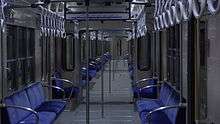
Line C was originally served by Siemens-Schuckert Orenstein & Koppel rolling stock, which were replaced in 2007 by Nagoya rolling stock transferred from Line D as 100 Series cars arrived on that line.[59] These cars began to be refurbished in 2014, equipped with air conditioning, new lighting and upholstery, among other changes.[60] The refurbishment of the 78 Nagoya cars is set to be completed in 2015–2016.[61] In 2014, 30 additional cars were purchased from the Nagoya Municipal Subway began to arrive in the country, belonging to the newer 5000 Series.[36]
With the incorporation of these trains in 2015, the line will consist of 108 Nagoya cars, though from different series and refurbished to increase the uniformity among them. No long term plans have been made as to what rolling stock the line will use when it is modernised, however the line is being updated with Trainguard Communications-based train control to allow for automatic train operation, meaning that it could be served by such trains.[46]
Line D

Line D was originally served by Siemens-Schuckert Orenstein & Koppel rolling stock, and then by the CAF/GEE cars from 1968. In 1999, cars from the Nagoya Municipal Subway were purchased second hand from Japan and incorporated into the line. At the time of the incorporation of the Nagoya cars, numerous Alstom Metropolis 100 Series cars were purchased and built in Brazil and Argentina in 2001 with the intention of incorporating them into Line A and replace the Brugeoise rolling stock. However, when these arrived, they were ultimately put in service on Line D where they remain to this day. More Alstom cars of the same type continued to be purchased in that decade up until 2009, making a total of 96 cars.[31]
The remaining Nagoya cars were moved to Line C when the Siemens-Schuckert Orenstein & Koppel cars were retired from that line in 2007 and were replaced with Fiat-Materfer cars, so the line continued to have two models of rolling stock. To make the rolling stock more uniform, 24 more modern 300 Series Alstom Metropolis cars were ordered in 2013 and are due to arrive in 2015, retiring the Materfer cars from the line and meaning that the line will be entirely composed of 120 Alstom cars.[38] However, in September 2015, the city presented a new modernisation plan which showed 84 new cars for the line instead of 24.[40] Beginning in 2014, the existing 100 Series cars began to receive a mid-life refurbishment, changing the upholstery and adding air conditioning units to the cars.[62] In early 2016, the final figure had been fixed at 60 new cars, meaning that the fleet will be composed of 156 Alstom Metropolis cars by 2017, retiring the Fiat-Materfer cars from the line.[63]
In June 2017, the first six Alstom 300 started operating in the line.[64]
Line E
.jpg)
The line was the last to be inaugurated with Siemens-Schuckert Orenstein & Koppel rolling stock, however these were replaced by Fiat-Materfer cars in the 1980s. The Materfer cars were later sent to Line D and Line D's CAF-GEE rolling stock was put to use on Line E, where it remains until this day, making up the entirety of the rolling stock on the Line.[4][5] When the new 200 Series and 300 Series rolling stock arrive for Lines A, D and H and the three lines are composed entirely of these two models, the CAF-GEE rolling stock will be retired from Line E and replaced once again with Materfer since the refurbished Siemens by Alstom and the Emepa Group are more than 80 years old and their performance is not good either.[65] This change is set to occur before the completion of the line's extension to Retiro.[24][66][67]
Line H
.jpg)
When Line H was opened in 2007, its short length meant that it could be temporarily served by Siemens-Schuckert Orenstein & Koppel cars until it was extended enough to warrant the incorporation of new rolling stock. For this purpose, 120 new Alstom Metropolis 300 Series cars were ordered from Brazil and began arriving in Buenos Aires in August 2015 in time for the line's extension northwards to Santa Fe.[45] The 20 trains with 6 cars each are to make up the entirety of the rolling stock of the line as it continues to be extended.[68]
The first 300 Series cars were put into service in July 2016, with the remainder being phased in throughout 2016 and 2017, increasing frequencies to an average of 3 minutes as a result of the increased number of trains as well as the use of Communication Based Train Control (CBTC).[69][70] The incorporation of these cars also meant the retirement of the Siemens-Schuckert Orenstein & Koppel cars, which was the oldest serving stock on the network.[71]
PreMetro
When the Premetro was opened in 1987, it was to be served by trams manufactured by the Argentine company Materfer. However, the cars were not ready for the line's inauguration, so it was briefly served by La Brugeoise cars re-bodied by the Emepa Group. The re-bodied cars were nicknamed Lagartos (Lizards) due to their green colour and were soon retired.[72] In 1988, the Materfer trams arrived on the line and the cars continue to serve on it to this day. Originally, 25 cars were to be built since there were to be two Premetro lines, however, only of these 17 cars were built for the E2 line since E1 was not built.[73]
Future lines
Three other lines are planned for the network, however the only line which has been approved for construction as of 2015 is Line F. Construction is due to begin in 2015 so it is yet unknown what rolling stock will be used, though they will be of modern characteristics, with platform screen doors and automated trains being considered.[47]
See also
| Wikimedia Commons has media related to Buenos Aires Metro rolling stock. |
References
- Fin de la espera: esta semana, el subte llegará al centro de Flores - La Nacion, 23 September 2013.
- Los viejos vagones del subte A realizarán viajes turísticos - InfoBAE, 3 September 2013.
- Coches históricos de la Línea A se donarán a museos y universidades - Perfil, 14 August 2015.
- Línea E: 70 años buscando pasajeros - EnElSubte, 20 June 2014.
- Ferrofilatelia - EnElSubte, 6 June 2010.
- Línea D - Buenos Aires Ciudad.
- Línea E - Buenos Aires Ciudad.
- Exhibieron la dupla histórica Preston para festejar el Bicentenario - EnElSubte, 26 May 2010.
- Subte: Remodelarán otros 40 coches Siemens - Taringa!, 19 November 2013.
- "El último viaje de los Siemens en la línea H". EnElSubte (in Spanish). 3 July 2016. Retrieved 4 July 2016.
- "Los Siemens que no fueron". EnElSubte (in Spanish). Retrieved 4 July 2016.
- Subte: 100 años avanzando - Buenos Aires Ciudad, 29 November 2013.
- La accidentada historia de los Siemens-FM - EnElSubte, 30 January 2014
- Trasladan Siemens para reformar a los talleres de Emepa en Pérez - EnElSubte, 16 December 2013.
- Vidal hace campaña con trenes de 1930 y miente sobre incorporación de coches - EnElSubte, 15 July 2015.
- "Rematan otros 11 coches Siemens". enelSubte.com (in Spanish). 31 October 2017. Retrieved 15 July 2018.
- Metro de Madrid ya había ofrecido los CAF 5000 al Subte en los años 80 - EnElSubte, 8 Julio 2014
- "Por el asbesto, suspenden la circulación de los CAF 5000". enelSubte.com (in Spanish). 20 February 2018. Retrieved 15 July 2018.
- Realizan pruebas con Brugeoise reconvertidos a 1500 V en la línea A - EnElSubte, July 2014
- Aprueban protección para todos los coches La Brugeoise - EnElSubte, 6 December 2013.
- "La AAT recibirá una dupla Siemens". EnElSubte.com. 18 September 2017. Retrieved 2 February 2018.
- "Los Amigos del Tranvía incorporaron dos antiguos coches de la línea B a su flota histórica". EnElSubte.com. 16 February 2018. Retrieved 16 February 2018.
- "El "coche único": radiografía de un proyecto inconcluso". enelSubte.com (in Spanish). 17 January 2019. Retrieved 17 January 2019.
- Metrovías oficializa quita de formaciones - EnElSubte, 4 June 2013.
- "Ponen en servicio dos trenes Fiat Materfer en la línea E". enelsubte.com. Retrieved 8 May 2017.
- El plan de SBASE para el Premetro - EnElSubte, 8 September 2014.
- "Mañana reabriremos la estación Fátima del Premetro". Buenos Aires Ciudad - Gobierno de la Ciudad Autónoma de Buenos Aires. Retrieved 25 April 2016.
- "Los Mitsubishi de la línea B vuelven a Japón". EnElSubte (in Spanish). 21 July 2016. Retrieved 21 July 2016.
- "Línea B: a cuatro años de la polémica compra, sólo funcionan dos de cada tres trenes usados" (8 August 2017). EnElSubte.com. Retrieved 8 August 2017.
- "Línea C: prometen que el primer tren CNR comenzará a funcionar este mes". enelSubte.com (in Spanish). 2 July 2018. Retrieved 17 July 2018.
- Finalizó la entrega de los Alstom Metrópolis - EnElSubte, 9 March 2009.
- Hacienda aprueba contrato de financiamiento para 105 coches CNR - EnElSubte, 24 July 2014.
- "El subte sumó 10 nuevos coches a la Línea A". Buenos Aires Ciudad - Gobierno de la Ciudad Autónoma de Buenos Aires. Retrieved 29 August 2016.
- Bochorno: los trenes usados de la B ya costaron más que comprar 0 km - EnElSubte, 30 June 2015.
- "SBASE asegura que los CAF 6000 que vinieron al país no tienen asbesto". enelSubte.com (in Spanish). 9 March 2018. Retrieved 17 July 2018.
- Se embarcan en Japón últimas dos formaciones Nagoya - EnElSubte, 18 May 2015.
- "Entró en servicio la primera formación Nagoya 5000 en la línea C". enelSubte.com (in Spanish). Retrieved 8 January 2016.
- SBASE anuncia nuevos coches con foto del Metro de San Pablo - EnElSubte, 21 January 2014.
- Llegaron al país seis coches nuevos con aire acondicionado para la línea H - La Nacion, 27 August 2015.
- Plan de modernización del Subterráneo de Buenos Aires - Buenos Aires Ciudad, September 2015.
- "Subte: a fin de año el 60% de la flota tendrá aire acondicionado". Buenos Aires Ciudad. Gobierno de la Ciudad Autónoma de Buenos Aires. Retrieved 19 April 2016.
- "Con coches nuevos, vuelve a circular la línea H — Subte". equilibrioinformativo.com. Retrieved 4 July 2016.
- "Quejas por la frecuencia de la línea H: inauguraron Facultad de Derecho sin sumar trenes". enelSubte.com (in Spanish). 11 July 2018. Retrieved 17 July 2018.
- https://enelsubte.com/noticias/ya-funcionan-cinco-trenes-nuevos-en-la-linea-d/. Missing or empty
|title=(help) - Descargan primera formación Alstom en el Taller Colonia - EnElSubte, 27 August 2015.
- Siemens modernizará las señales de la línea C - EnElSubte, October 2014.
- Confirman proyecto para desviar la línea F a Facultad de Derecho - EnElSubte, 25 November 2014.
- Preadjudican 105 coches a CNR para la línea A - EnElSubte, May 2013
- SBASE reconoce que la frecuencia de la línea A es "inadmisible" - EnElSubte, 5 March 2014.
- Embarcaron primeros dos trenes de la segunda tanda de CNR - EnElSubte, 4 February 2015.
- Incorporarán nuevos trenes a la línea A: realizan pruebas - EnElSubte, 5 June 2015.
- enelsubte. "SBASE compra a Metro Madrid 73 coches usados CAF 6000 para la línea B | enelSubte.com". enelsubte.com. Retrieved 29 August 2015.
- Roby Danna. "Subtes: Ciudad compra más de 70 vagones Serie 6000 a Madrid | Noticias de la Ciudad de Buenos Aires". parabuenosaires.com. Retrieved 29 August 2015.
- "La serie 6000 del metro de Madrid rumbo a Argentina - Trenvista". ferronoticias.net. Archived from the original on 3 November 2014. Retrieved 29 August 2015.
- "Metro de Madrid ingresa 32,6 millones de euros con la tercera venta de trenes a Buenos Aires | Metro de Madrid". metromadrid.es. Retrieved 29 August 2015.
- La peor compra de material rodante de la historia del Subte - EnElSubte, 6 March 2015
- Piden informes al GCBA por los trenes usados para la línea B - EnElSubte, 15 March 2015
- Los "nuevos" trenes de la línea B siguen sin funcionar - EnElSubte, 28 August 2015.
- Entra en servicio un tren Nagoya reformado - EnElSubte, 23 October 2014.
- Aire acondicionado para los Nagoya - 21 October 2014.
- Aprobaron el presupuesto de SBASE para 2015 - EnElSubte, 24 April 2015.
- Instalarán aire acondicionado sólo en la mitad de los Alstom de la línea D - 27 March 2015.
- "La Ciudad coloca deuda para comprar 60 coches Alstom para la línea D". EnElSubte (in Spanish). 28 January 2016. Retrieved 7 July 2016.
- "Línea D: ya circula la primera formación 0 km y con aire acondicionado". Buenos Aires Ciudad. Retrieved 6 June 2017.
- "Transferirán tres trenes Materfer a la línea E". enelsubte.com. Retrieved 9 April 2017.
- Subtes: el gobierno porteño planea renovar la mitad de la flota para el 2015 - InfoBAE, 23 January 2013
- Ciudad confirma que la extensión de la línea E abrirá recién en 2017 - EnElSubte, 23 July 2015.
- Subtes: el gobierno porteño planea renovar la mitad de la flota para el 2015 - InfoBAE, 29 January 2013.
- "Reabrió la línea H y los pasajeros se quejan por la frecuencia". EnElSubte (in Spanish). 4 July 2016. Retrieved 7 July 2016.
- "Reabrió la línea H de subtes con su flota renovada". www.nueva-ciudad.com.ar. Retrieved 7 July 2016.
- "El último viaje de los Siemens en la línea H" (in Spanish). 3 July 2016. Retrieved 7 July 2016.
- El discreto y perverso encanto del progreso - La Nacion, 5 January 2013.
- Cross, Barry (April 2001). "Buenos Aires: Brand new pre-Metro line" Archived 4 March 2016 at the Wayback Machine. Tramways & Urban Transit, pp. 136–137. UK: Light Rail Transit Association/Ian Allan Publishing.